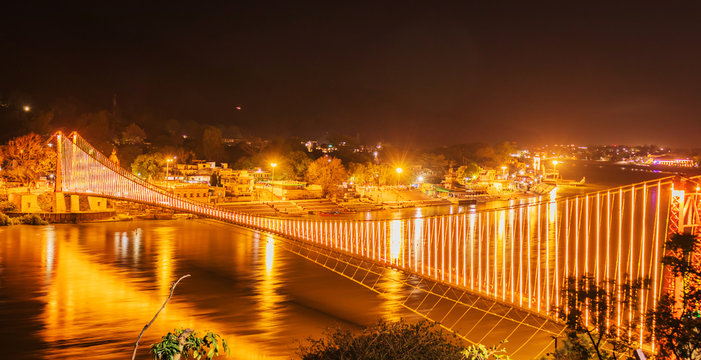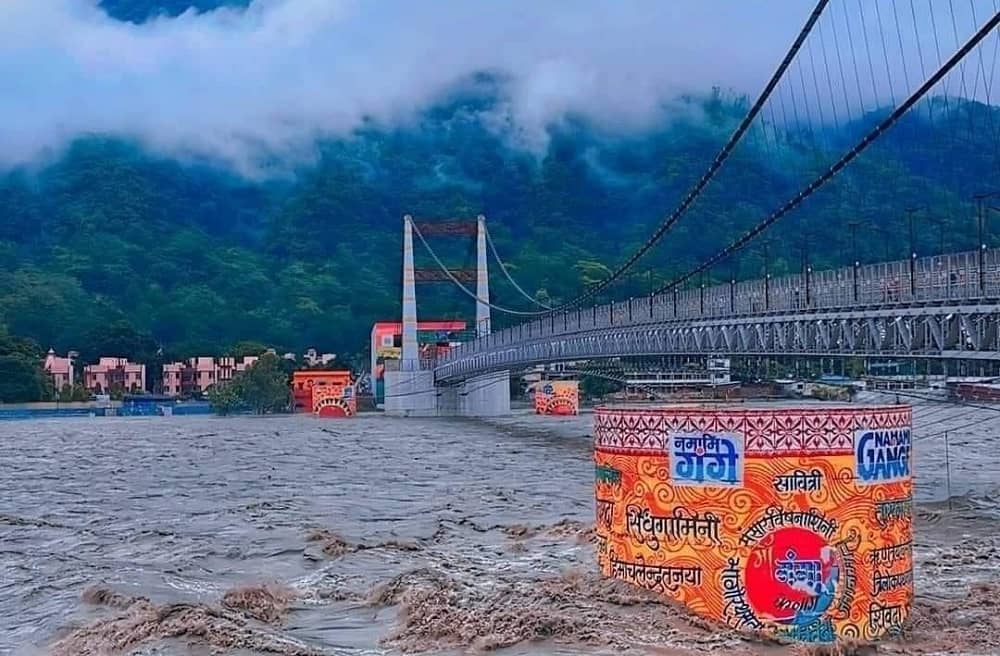
If there’s one city where mythology dances with the breeze and spirituality flows through every street, it’s Rishikesh. Among its many marvels, the `legendary Ram Jhula and Laxman Jhula are more than just suspension bridges — they are timeless symbols of faith, stories, and serenity.
In this blog, we’ll dive into the mythological tales, historical significance, and current status of these two iconic landmarks and introduce you to the city’s latest spiritual connection — Janki Setu.
Rishikesh is not just a travel destination; it’s a pilgrimage for the soul. Known as the Yoga Capital of the World, the town welcomes seekers of peace and wisdom from across the globe. At the heart of its charm are the two timeless bridges — Ram Jhula and Laxman Jhula — gracefully arching over the Ganges, linking sacred ashrams, vibrant temples, and bustling local bazaars.
Ram Jhula: A Walk Between Two Worlds
Constructed in 1986, Ram Jhula is a 450-feet-long iron suspension bridge that connects Sivananda Ashram on one side of the Ganga to Swarg Ashram on the other.
What makes Ram Jhula special?
- It’s pedestrian-only, making it a calm passage for those on spiritual journeys.
- The bridge leads you to popular spiritual centers like Parmarth Niketan, Gita Bhawan, and Baba Kali Kamli Wale Ashram.
- The river views at sunrise or sunset from here are breathtaking — especially when accompanied by the sound of temple bells and chanting mantras.
The Spiritual Story
Though Ram Jhula doesn’t have a direct reference in mythological texts like Laxman Jhula does, it stands as a symbol of dharma and devotion, honoring Lord Ram’s ideals. The bridge is often walked with reverence by devotees heading to sacred spots.
Laxman Jhula: Where Legends Took Their First Step
Just 2 kilometers upstream from Ram Jhula stands Laxman Jhula, the older and historically significant suspension bridge, built in 1929.
The Myth That Built a Bridge
Legend says that Lakshman, the younger brother of Lord Ram, once crossed the Ganga here using a jute rope. The spot became sacred, and in his honor, this modern bridge was constructed.
It’s easy to feel the weight of ancient stories as you stand at the site where divinity once walked.
Scenic and Symbolic
The views from Laxman Jhula are picture-perfect. On either side of the bridge, you’ll find:
- Trayambakeshwar Temple (13-storey temple) — a favorite photo spot.
- Street shops selling spiritual items, rudraksha malas, and souvenirs.
- Cozy cafes and juice stalls offering a place to pause and reflect.
Why Is Laxman Jhula Closed?
In July 2019, the government closed Laxman Jhula due to its weakening structure and safety concerns. While walking on the bridge is no longer allowed, it remains a top attraction for viewing and photography.
There are talks of building a new bridge in its place, but for now, the structure stands as a revered memory.
Janki Setu: A New Chapter for Rishikesh
With Laxman Jhula closed, Janki Setu (also known as Sita Pul) has taken center stage. Inaugurated in 2020, this modern bridge is named after Goddess Sita (Janki) — completing the divine trio: Ram, Lakshman, and Sita.
Why It’s Special
- Built with modern design, it supports both pedestrians and two-wheelers.
- Offers easy access between Swarg Ashram and nearby areas.
- Becomes magical during sunrise walks or evening Aarti time.
With this new bridge, Rishikesh beautifully combines tradition and modernity — a rare harmony seen in very few places.

Things To Do Near the Bridges (Ram Jhula & Lakshman Jhula)
If you’re planning a visit, here are some must-do activities around Ram Jhula and Laxman Jhula:
- Attend the Ganga Aarti at Parmarth Niketan
- Visit Beatles Ashram and feel the creative energy left behind by the legendary band
- Try herbal teas and smoothies at cafes near the ghats
- Shop for rudraksha malas, spiritual books, and handcrafted souvenirs
Enjoy local delights like Aloo Puri, Kachaudi, and Jalebi
Best Time to Visit the Bridges (Ram Jhula & Laxman Jhula)
Rishikesh is pleasant almost all year, but the best times to visit are:
- October to March – For spiritual festivals, yoga sessions, and cool weather.
- April to June – Great for adventure sports like white-water rafting.
- July to September – Monsoon season, less ideal due to heavy rains and river swelling.
Travel Tips for First-Time Visitors
- Walk slowly across the bridges — soak in the views and energy.
- Avoid carrying loose items in your hand (monkeys love a quick snatch).
- Visit early morning or late evening for less crowd and better light.
- Always respect local traditions — remove footwear near temples and dress modestly.
- Carry a refillable water bottle and some cash for small purchases.
Ram Jhula and Laxman Jhula aren’t just bridges — they’re pathways between the past and the present, between mythology and modern travel. Whether you’re a spiritual seeker, a history lover, or someone looking for peace, these bridges offer an unforgettable journey across the sacred Ganga.
And now, with Janki Setu rising as a symbol of strength and modern devotion, Rishikesh continues to evolve while staying rooted in its spiritual soil.
Come walk these bridges. Let the wind whisper old stories in your ears. Let the river bless you as it flows beneath. Let Rishikesh change you — just like it has for countless others.
Frequently Asked Questions
Q1:Is Laxman Jhula open for walking?
No, the bridge has been closed for safety reasons since 2019. If you’re wondering why Laxman Jhula is closed and what to see instead in Rishikesh, head to the nearby Ram Jhula or explore the newly built Janki Setu.
Q2: How far is Ram Jhula from Laxman Jhula?
Approximately 2 kilometers — an easy and scenic walk. Many travelers use this route when comparing Ram Jhula vs Laxman Jhula vs Janki Setu for their sightseeing experience.
Q3: Can vehicles cross Janki Setu?
Yes, two-wheelers and pedestrians can cross the bridge. It’s a vital new connection for those visiting Swarg Ashram and spiritual places near Ram Jhula and Laxman Jhula.
Q4: Which bridge should I visit first?
Start with Ram Jhula — it’s centrally located and active. Then, explore the area around Laxman Jhula.
Q5: Is photography allowed on the bridges?
Absolutely! But be cautious of monkeys and avoid using drones without permission.
If you loved this post, share it with fellow travelers or comment below with your own experiences at Ram Jhula and Laxman Jhula.
Until next time, may your journey be as sacred as the Ganga herself.
🕊️ Namaste from Rishikesh Vibes
